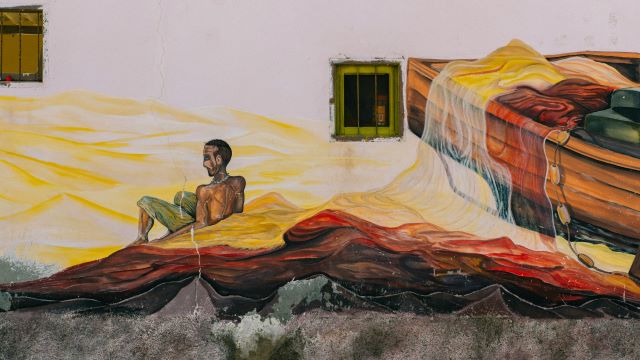Off the coast of West Africa, scattered like a constellation in the Atlantic, lies Cabo Verde—an archipelago where continents and centuries meet. Here, the echoes of African rhythms intertwine with the lyrical traces of Portuguese verse and the sunlit warmth of Brazilian sensibilities. The islands’ culture, shaped by migration, resilience, and the sea, has grown into a living mosaic, its colors shifting with each generation yet anchored in deep tradition.
The Soundtrack of an Island Nation
In Cabo Verde, music is less an art form than a pulse. The slow, bittersweet strains of morna—sung in the lilting cadence of Cape Verdean Creole—carry the weight of longing, the memory of voyages, and the promise of return. Made famous to the world by the late Cesária Évora, the “barefoot diva,” morna moves with a deliberate grace, its guitars, cavaquinhos, violins, and accordions weaving melodies that linger long after the last note fades.
Other genres rise with a quicker tempo. Funaná, once suppressed under colonial rule, bursts with fast-paced accordion riffs that speak of rebellion as much as celebration. Coladeira offers a playful counterpoint, its rhythms inviting movement, its lyrics often tinged with humor. For many Cabo Verdeans, music is not entertainment but inheritance—storytelling that crosses oceans and generations.
Language as Heritage
Though Portuguese remains the official language of administration and education, the language of daily life is Kriolu, a creole shaped from Portuguese and West African tongues. It carries the collective memory of the islands, from the proverbs passed between elders and children to the songs sung in narrow streets and windswept fishing villages.
Kriolu is more than communication—it is identity. In it, the history of the islands finds its most authentic voice, blending resilience with adaptation. Its preservation is not a nostalgic act but a cultural necessity, even as Cabo Verde’s diaspora grows and global influences seep in.
Festivals in Full Color
Cultural expression in Cabo Verde often takes its most vivid form during festivals. Nowhere is this more visible than in Mindelo’s Carnival on the island of São Vicente, a pageant of movement and color that rivals its Brazilian counterpart in scope and energy. Elaborate costumes, intricate floats, and street performances fill the city with a heady mix of African beats and Portuguese rhythms.
On the islands of Santiago and Fogo, Tabanka recalls a more solemn history. This festival, rooted in African tradition, commemorates resistance to colonial rule and slavery through drumming, parades, and the ceremonial crowning of a symbolic king and queen. Both joyous and defiant, it stands as a reminder of the islands’ enduring spirit.
Art in the Everyday
In the streets of Mindelo, murals bloom across weathered walls, and galleries showcase work that speaks to both heritage and horizon. Artists such as Tchalé Figueira explore themes of identity, exile, and belonging, drawing on the visual language of the islands’ African roots and colonial past. Traditional crafts—woven baskets, hand-formed pottery—remain integral to island life, their designs passed down like stories.
The art scene is not confined to the archipelago. Cabo Verdean artists abroad often carry fragments of home into their work, reframing it for audiences far from the Atlantic breeze.
The Flavors of History
The national dish, cachupa, simmers slowly—corn, beans, fish or meat melding over hours into a communal meal. It is food as memory, often served at family gatherings, its preparation as important as its taste.
Seafood remains central: lobster grilled over open flames, octopus stewed with herbs, tuna prepared with a nod to Portuguese techniques. Spiced with African influences and tempered by European traditions, Cabo Verdean cuisine reflects the islands’ layered past.
Words Across the Water
From the revolutionary writings of Amílcar Cabral to the wry narratives of Germano Almeida, Cabo Verde’s literature captures the tension and beauty of island life. These works often trace the themes of migration and return, of a homeland both fixed in memory and constantly changing.
Through poetry, novels, and oral storytelling, the Cabo Verdean voice continues to travel, finding audiences far beyond the horizon.
A Living Cultural Archive
Cabo Verde’s culture does not reside in museums or monuments alone. It moves in music, in language, in festivals that spill into streets, in flavors that tell of voyages and homecomings. It is an inheritance continually reshaped, both by those who remain and those who return from faraway shores.
Sources:
- Lobban, Richard A. Cape Verde: Crioulo Colony to Independent Nation. Westview Press, 1995.
- Fryer, Peter. Rhythms of Resistance: African Musical Heritage in the Americas. Pluto Press, 2000.
- Andrade, Mário Fonseca. “Creole Identity and Cultural Expression in Cape Verde.” Journal of African Cultural Studies, vol. 12, no. 2, 1999, pp. 125–138.

